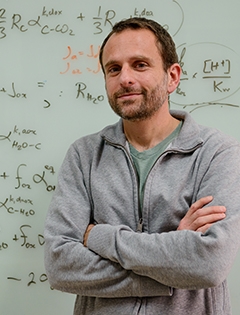The chemistry of creation
Earliest life emerged in mildly acidic oceans
Briefs

You don't often hear your local news broadcaster say "Folks, today's pH value of the ocean is 6.4!" But ocean pH is quite an important measurement.
It not only signifies the relative acidity or alkalinity of sea water, but also governs the ability of calcium carbonates, the main component of marine shells and eggs, to form, as well as the availability of metals that provide vital nutrition for aquatic animals. pH also governs the partitioning between CO2 in the atmosphere, and the carbon dissolved in the ocean—a balance that is a dominant factor in the Earth’s climate.
Now, Dr. Itay Halevy of the Weizmann Institute’s Department of Earth and Planetary Sciences, together with Dr. Aviv Bachan of Stanford University, has developed a model of how seawater pH has changed since ancient times. Integrating data and existing models of the chemical makeup of the Earth’s atmosphere, oceans, and crust, the scientists’ new model identifies the main “culprit” behind seawater’s changing chemistry: the gradual decrease in atmospheric CO2 levels in response to an increase, over eons, of the brightness of the Sun.
According to the model, which was reported in Science, the oceans of the distant past were mildly acidic, then, over eons, acquired more alkaline pH levels.
The study found that three to four billion years ago, the pH of ocean water was acidic in the range of 6.0 to 7.5—somewhere between that of milk and human blood—as opposed to the more recent, relatively alkaline values of 7.5 to 9.0. The findings help clarify the chemical conditions under which primitive life emerged and thrived in the early oceans - and also help us understand the dynamic changes that contributed to the modern ocean’s chemical balance.
The influence of the Sun
To account for the change over time scales exceeding 100 million years, the team developed a statistical model of seawater pH as a function of a number of factors. One of these is the atmospheric concentration of CO2, which is thought to have decreased over Earth’s history due to a gradual brightening of the Sun. Since its birth 4.5 billion years ago, the Sun's luminosity has slowly increased because, as the eons roll by, the Sun burns up the hydrogen in its core. The helium remnants left behind are denser than hydrogen, so the nuclear reactions run a little hotter, and the Sun brightens.
In parallel with solar brightening, which decreased the acidity of the early oceans by decreasing atmospheric CO2 concentrations, the Earth itself cooled. This cooling reduced the circulation of seawater through the ocean crust, contributing to a decrease in ocean acidity over time.
If we want to apply these historical insights to today’s oceans, and to the changing levels of atmospheric CO2 which are widely believed to be at the heart of climate change, Dr. Halevy says we have to remember that changes in ocean pH occurred over geological timescales—millions of years. “The acidification associated with today’s increased CO2 is occurring rapidly, and our model does not apply to the short-term problem,” he says. “Hundreds of thousands of years from now, the oceans will have found a new balance, but between now and then, marine organisms and environments may suffer.”
Cover image: Stromatolites in the ocean. Stromatolites are layered accretionary structures formed in shallow water by trapping, binding and cementation of sedimentary grains by biofilms (microbial mats). Present-day stromatolites show similarities with fossil stromatolites as old as 3.7 billion years, and are considered to be analogs for ancient microbial communities.
Dr. Itay Halevy’s reseach is supported by the Helen Kimmel Center for Planetary Science; the Deloro Institute for Advanced Research in Space and Optics; and the Wolfson Family Charitable Trust. Dr. Halevy is the incumbent of the Anna and Maurice Boukstein Career Development Chair in Perpetuity.

Dr. Itay Halevy